by Nina
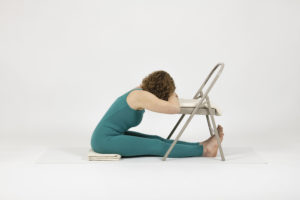
I have always known that seated forward bends are considered quieting poses, but it wasn’t until I interviewed Shari Ser about baroreceptors several years ago (see Talking About Baroreceptors and Yoga) that I discovered that forward bends are quieting for the same reason that inverted poses are calming: pressure on the baroreceptors causes your body to lower your blood pressure and reduce your stress hormones. No wonder three minutes in a forward bend seems to turn off the noise in my head and put me in a relaxed, almost dreamy state. (For general information about baroreceptors and inverted poses, see Why You Should Love Your Baroreceptors.)
But Shari’s observations about forward bends made me curious because you’re not exactly upside down in a forward bend and I had previously learned that it was gravity that was putting pressure on your baroreceptors. (I’m like that about yoga, I always want to know why!) So I asked Baxter if he knew why forward bends had the same effect as inversions. Here’s what he said:
“Regarding the beneficial effect of seated forward folds on lowering blood pressure, I would hypothesize that the fold brings enough pressure onto the abdominal area to place pressure on the main blood vessel in the belly, the abdominal aorta. If this caused a temporary narrowing in the vessel, this could create a back pressure up to the baroreceptors in the neck and aortic arch. This would have the same effect as inversions.”
By now you may be reading this and thinking, “That’s fine for you to say, but I hate forward bends. Just the thought of doing them makes me feel cranky, not relaxed.” Yes, I realize that I’m one of the lucky few who is flexible enough to be comfortable in forward bends. And I do know that a large number of people, especially those with tight hamstrings, are, shall we say, quite the opposite of comfortable in forward bends. For those people, discomfort in the pose negates the soothing effects because being physically uncomfortable tends to irritate the nervous system.
But does that mean you have to miss out entirely on the blissful feeling I’ve just described? Definitely not! Because in today’s post I’m going to present two different ways to prop your forward bends to take remove the yuck and bring on the bliss. Try them both and see which one works best for you. For people with back problems, the second technique might be better because in that one you keep your spine long, rather than rounded.
Bolster under Straight Leg or Legs
With this technique, you place a round bolster or a very thick blanket roll under the knee of your straight leg or both legs if you are doing Paschimottanasana (as shown in the photo below). With the bolster supporting you this way, you knee or knees will be bent and supported. This can be very helpful for people, like Baxter, who is shown here, who have very tight hamstrings.
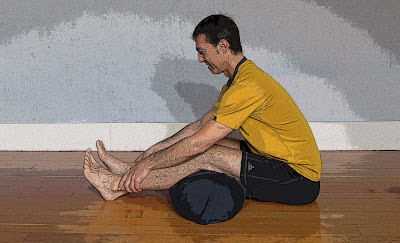
Bend from your hips to come into the forward bend and then slowly round your back into a gentle curve. Baxter is someone who normally doesn’t enjoy forward bends, but just look how comfy he looks in these photographs!
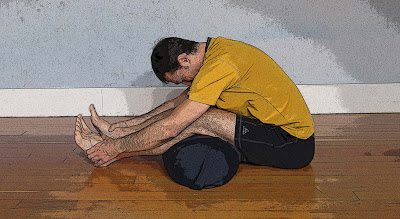
To experience the soothing effects of the pose, stay in the pose at least three minutes (I’ve found it takes that long for the pose to work its magic). When you are ready to come out of the pose, come out very slowly, rolling up to an upright position.
Resting Your Arms and Head on a High Support
In the second version of a supported forward bend, you use a bench or chair on which to rest your arms and head and you use a folded blanket under your pelvis. Position the chair over your straight leg (or legs), far enough away so you can keep your spine long and straight when you come into the forward bend. If the bench or chair isn’t high enough for you to easily reach, add folded blankets or towels to increase the height. To come into the pose, bend from your hip joints, keeping your spine straight and long (in this version you do not round your back). Place your folded arms on the chair or bench, and rest your head on your hands. If possible, catch your forehead skin on your hands and tug it gently down toward your eyebrows.
Here are three different seated forward bends practiced using this technique. Experiment to see which is the most comfortable for you because it varies depending on your body type (the flexibility of your hips vs. the backs of your legs).
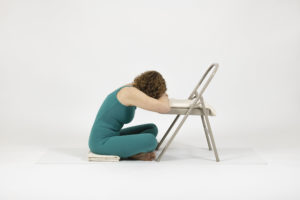

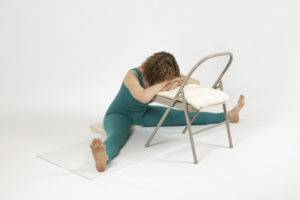
To experience the soothing effects of this pose, stay in the pose at least three minutes. When you are ready to come out of the pose, come out very slowly, using your hands to press yourself into an upright position.
In the past, I often taught the chair version of seated forward bends, and I was always so pleased to see almost everyone in the class come out of the pose with a calm, relaxed expression on their faces. I’d love to hear how it feels to you!
For cautions for these forward bends (and forward bends in general), see Which Forward Bends Are Safe?
Follow Yoga for Healthy Aging on Facebook ° To order Yoga for Healthy Aging: A Guide to Lifelong Well-Being, go to Amazon, Shambhala, Indie Bound or your local bookstore.


Never thought about bolster under the knees. I’m one of those tight hamstring people and endure seated forward folds. The bolster trick totally works! And I can easily use it in Yin class since we have props handy.